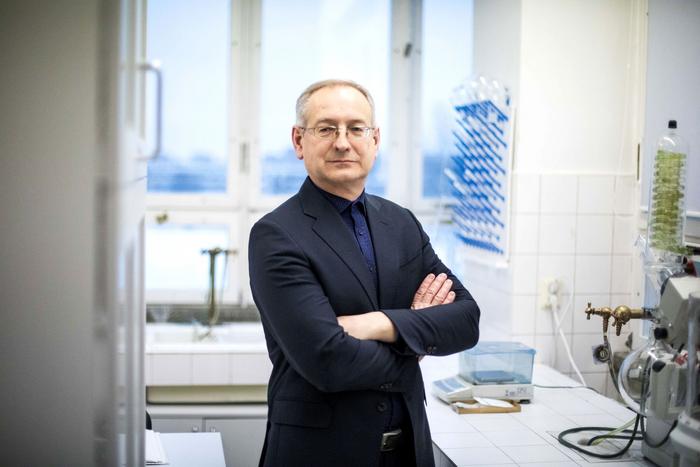Researchers from Kaunas University of Technology (KTU), Lithuania, who contributed to the development of record-breaking solar cells a few years ago, expanded their invention. The self-assembled monolayers can now be applied not only in inverted but also in regular structure perovskite solar cells.

Credit: KTU
Researchers from Kaunas University of Technology (KTU), Lithuania, who contributed to the development of record-breaking solar cells a few years ago, expanded their invention. The self-assembled monolayers can now be applied not only in inverted but also in regular structure perovskite solar cells.
Self-assembling molecules arrange themselves into a single-molecule-thick layer and in this case, they act as an electron-transporting layer in solar cells.
“The molecules that make up these monolayers, like a clever glue, coat the surface of the constructed devices with a thin one molecule thick layer. And this is not random, they don’t stick wherever they go, but attach themselves by chemical bonds only where they are in contact with conductive metal oxide,” explains Tadas Malinauskas, Professor at KTU’s Faculty of Chemical Technology and one of the inventors of the new technology.
According to Malinauskas, the development of such a layer is a relatively simple and material-efficient process that requires a glass substrate with an electrically conductive metal oxide layer to be immersed in or sprayed with a highly diluted solution of the compound.
In this way, the self-assembling molecules are only attached to the surface of the metal oxide, and those that do not stick are washed away. This way a thin layer is created only where it is needed.
A crucial step in the development of the next generation solar cells
A team of KTU researchers has been synthesising and studying charge-transporting organic materials for several years. Previous experiments have focused more on molecules used for positive charge transfer in the perovskite solar cells.
“We can already say with confidence that these molecules have given a major boost to the development of the next generation solar cells. So, our next step is quite logical: to develop analogous molecules that can carry negative charges, and to apply these materials in perovskite solar cells,” says Vytautas Getautis, professor at the KTU Faculty of Chemical Technology and Head of the research group in charge of invention.
Although it is a very thin layer, the role it plays in solar cells is extremely important. Malinauskas says that the best analogy for its function is the subway. “This layer, like an automatic gate on the subway, allows only one type of charge to pass through and continue its journey towards the electrode,” he says.
In this way, self-assembled molecules increase the efficiency of solar cells.
Perovskite solar cell structures differ in the sequence of layers. In the regular structure, a negative charge transporting layer is formed on a transparent substrate, followed by light-absorbing and positive charge transporting layers. In solar cells with an inverted structure, the positive and negative charge transport layers are swapped.
Inventor and KTU PhD student Lauryna Monika Svirskaitė says that the main difference between the two structures is the areas of their application.
“The regular structure is more widely used to study low-cost, easier-manufactured but less efficient solar cells. The inverted architecture allows them to be used in the construction of much more efficient combined devices, also known as tandem devices,” says Svirskaitė.
At the moment, as both structures are being intensively researched, the KTU scientists believe that the new invention is just as significant and promising as the last one.
The strongest inventions in the KTU patent portfolio
The new invention is the result of a collaboration with scientists from King Abdullah University of Science and Technology (KAUST).
“We, KTU chemists, were responsible for the development, improvement, and optimisation of the materials and coating technology, while our colleagues from Saudi Arabia investigated the performance of it in solar cells,” reveals Malinauskas.
Greta Žėkienė, Head of Intellectual Property Management at KTU’s National Innovation and Entrepreneurship Centre (NIEC), says that the demand for this invention is surprisingly high. In this case, interest in the invention’s industrial use preceded the filing of the patent application.
According to Žėkienė, the search for partners usually starts after a patent application is filed, and most of the time an invention receives attention only after the publication of a scientific article is released.
“A Japanese company, with whom we already have several licences for inventions in this field, immediately expressed the interest to have the innovation in their product portfolio. They were waiting for us to prepare a patent application. The process of negotiating a licence agreement started right away,” says Žėkienė.
She emphasises that it is not necessary to obtain a patent for the commercialisation of an invention. While it depends on the individual case, commercialisation of an invention can take place at any time if a business declares its intention to license or take over all the property rights.
The Head of Intellectual Property Management at KTU says that inventions in the field of solar cells made by the Synthesis of Organic Semiconductors research group are the strongest in KTU’s patent portfolio and receive a lot of interest from businesses in this field. “We feel proud and acknowledged when companies want to start using the inventions as soon as possible,” adds Žėkienė.
The article Nonfullerene Self-Assembled Monolayers As Electron-Selective Contacts for n-i-p Perovskite Solar Cells was published in ACS Energy Letters 2024 and can be accessed here.
Journal
ACS Energy Letters
Method of Research
Experimental study
Article Title
Nonfullerene Self-Assembled Monolayers As Electron-Selective Contacts for n-i-p Perovskite Solar Cells
Article Publication Date
24-Mar-2024
COI Statement
The authors declare no conflict of interest.



